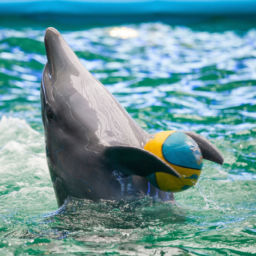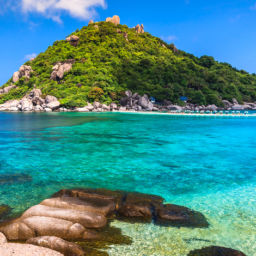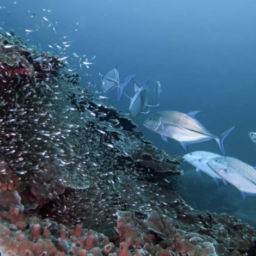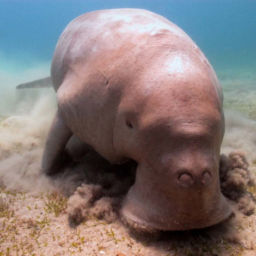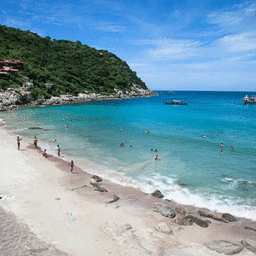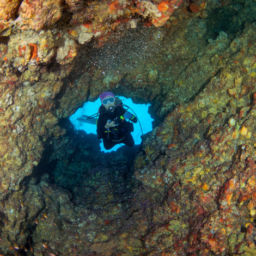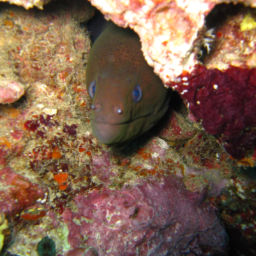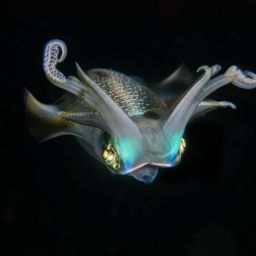Nine tiny islands make up the Similan Marine National Park off Thailand’s coast. Their white sand beaches and tropical jungle interiors offer a glimpse of paradise, but what’s below the surface is the real attraction for thousands of visitors every year: scuba diving in the Similan Islands is world-class.
The Similan Islands are regarded as having the best scuba diving in Thailand, with a diversity of dive sites, quality reefs, and abundant marine life.
From gentle fringing reefs of hard and soft coral teeming with life on the eastern side, to wild currents and rugged granite boulders on the west, the Similan Islands have something to keep divers of all levels coming back time and time again. Here’s a look at some of the best dive sites in the area.
Anita’s Reef
Anita’s Reef is a favorite with photographers, considered by many to be one of the best dive sites in the area. Beginning shallow, the sloping reef extends down to 92 feet (28 m) making it ideal for all divers.
Stunning bommies, covered in soft corals, sea fans, table coral, and staghorn coral form the topography. These bommies hide longnose hawkfish, glassfish, and countless juvenile fish. Spotted garden eels and Kuhl’s stingrays love the sandy bottom. Giant trevally hunt among the boulders and large table corals. Look out in the blue and you may be lucky enough to spot the majestic, 6.5-foot (2 m) long fantail stingrays.
Beacon Point
Beacon Point consists of huge boulder formations and large patches of hard coral which drop down to 130 feet (40m). It’s a great site for a multi-level dive with interesting features at all depths. The boulders are covered in gorgonian sea fans, wire coral, and brain coral.
All are home to colorful reef fish like wrasse, parrotfish, multiple species of chromis, and surgeonfish. Numerous nudibranchs hide out in the coral and some of the larger boulders provide shelter for redtoothed triggerfish. Beacon Point also offers a good chance of seeing eagle and manta rays, leopard sharks, and other smaller reef sharks.
Donald Duck Bay
A rock looking like the cartoon character’s head provided Donald Duck Bay with its name. This dive is relatively easy, with a combination of boulders and flat sand at around 65 feet (20 m).
There are some nice swim-throughs among the rocks, which are home to crustaceans, cephalopods, decorator crabs, squid, cuttlefish, red octopus, painted rock lobster, and moray eels. Because of the easy conditions, Donald Duck Bay is popular for night diving when these creatures come out to play.
Christmas Point
A wide area covered with submerged stacked boulders makes up Christmas Point. The arches created by the boulders make for some fun swim-throughs. Big fish have taken a liking to this site — white and blacktip reef sharks, napoleon wrasse, barracudas, tunas, and groupers are all regulars.
Gorgeous soft-coral gardens occupy the crevices between the rock; these are the hang-out spots for nudibranchs, frogfish, and ribbon eels. You’ll need more than one dive to really appreciate all Christmas Point has to offer.
Breakfast Bend
Breakfast Bend is a popular choice for the first dive of the day with the beautiful dawn light. A long, shallow reef begins at 15 feet (5 m) and slopes down to 60 feet (18 m) before a steep drop-off to 110 feet (34 m).
The quantity of marine life here is staggering. Bannerfish, groupers, damsels, and angelfish are just some of the many fish that populate the site. Hunting trevallies dart into clouds of baitfish alongside large schools of batfish and yellowtail barracuda. It’s also common to see more than one leopard shark on a dive at Breakfast Bend. Don’t forget to keep an eye out for turtles when making your safety stop.
East of Eden
One of the most stunning dive sites of the Similan Islands is East of Eden. Many describe it as ‘aquarium diving’ thanks to the sheer density of reef life. Like all the diving on the east coast of the Similan Islands, the reef is a mix of hard and soft coral sloping down to 130 feet (40m). Most notable are the huge clusters of staghorn coral.
The true highlight is a large rock known as Gluay-Mai or The Orchid Garden, with its hot-pink anemones. East of Eden is popular with turtles and sharks, which hang out in the sandy areas beyond the reef. If you’re into macro-photography, this is a site you don’t want to miss.
Elephant Head Rock
Probably the most famous and popular dive site is Elephant Head Rock, named for the shape of the rock protruding above the water. Below the surface, giant granite boulders form a complex labyrinth of swim-throughs, tunnels, and gorges, making it a real playground for divers.
Nurse sharks rest under ledges and you can see several species of snapper sheltering below the overhangs. Soft corals and sea fans line these archways and are home to an array of creatures.
Expect blue-ringed angelfish, titan triggerfish, cuttlefish, mantis shrimp, yellow goatfish, and the Andaman sweetlips, to name just a few. With the possibility of strong surging currents, Elephant Head Rock is for more advanced divers. Keep an eye on your buoyancy as the site bottoms out at 165 feet (50 m).
Get the most out of scuba diving the Similan Islands
There’s no better way to dive the Similan Islands than on a liveaboard. With more than 20 dive sites scattered about, it’s impossible to get the best out of the diving with day trips alone. Liveaboards depart from Khao Lak and Phuket, and there are plenty to choose from. Trips cater for all budgets from backpacker no-frills trips to luxury five-star cruises.
If time is against you, but you still want a taste of some of the great diving in the Similan Islands, day trips from Khao Lak are possible. Expect a long day out as you will have a 56-mile (90 km) round trip.
The best time to dive the Similan Islands
Liveaboards in the Similan Islands only operate from mid-October to mid-May when the weather conditions are most stable. Being so close to the equator, water temperatures range from 79 to 84 F (26 to 29 C). Toward the end of February, the currents become stronger, attracting the larger pelagic life such as manta rays and whale sharks.
With the dive sites closed for half a year, the reefs get some much-needed time to recuperate after a busy season of boats operating in the area and constant diving. Fortunately, the offseason coincides with the spawning period for many fish. The Similan Islands have time to get ready for the next eager divers, keen to experience some of the best diving in the world.





